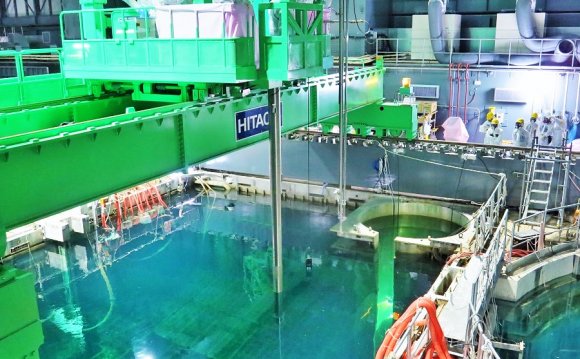
 In a test expected to be attended by Angela Merkel, the chancellor, researchers will inject a tiny amount of hydrogen into a special device and heat it until it becomes a super-hot gas known as plasma – mimicking conditions inside the sun.
In a test expected to be attended by Angela Merkel, the chancellor, researchers will inject a tiny amount of hydrogen into a special device and heat it until it becomes a super-hot gas known as plasma – mimicking conditions inside the sun.
The experiment at the Max Planck Institute in Greifswald, north-east Germany, is part of a worldwide effort to harness nuclear fusion – a process in which atoms join at extremely high temperatures and release large amounts of energy.
Technical director Hans-Stephan Bosch holds up computer images showing the first plasma generated at the institute. Photograph: Stefan Sauer/APMerkel, who is a doctor of physics, is expected at Wednesday’s event, which is happening in her constituency.
Advocates of nuclear fusion acknowledge the technology is probably decades away but argue that it could replace fossil fuels and conventional nuclear fission reactors.
Construction has begun in southern France on ITER, a huge international research reactor that uses a strong electric current to trap plasma inside a doughnut-shaped device long enough for fusion to take place. The device, known as a tokamak, was conceived by Soviet physicists in the 1950s and is considered fairly easy to build but extremely difficult to operate.
The team in Greifswald is focused on a rival technology invented by the American physicist Lyman Spitzer in 1950. Called a stellarator, the device has the same doughnut-shape as a tokamak but uses a complicated system of magnetic coils to achieve the same result.
That device should be able to keep plasma in place for much longer, said Thomas Klinger, who heads the project. “The stellarator is much calmer, ” he said. “It’s far harder to build but easier to operate.”
Known as the Wendelstein 7-X stellarator, the €400m (£300m) device was first fired up in December using helium, which is easier to heat. Helium also has the advantage of “cleaning” any minute dirt particles left behind during the construction of the device.
David Anderson, a professor of physics at the University of Wisconsin, who isn’t involved in the project, said the project in Greifswald looked promising.
“The impressive results obtained in the startup of the machine were remarkable, ” he said. “This is usually a difficult and arduous process. The speed with which W7-X became operational is a testament to the care and quality of the fabrication of the device and makes a very positive statement about the stellarator concept itself. W7-X is a truly remarkable achievement and the worldwide fusion community looks forward to many exciting results.”
Related: When you wish upon a star: nuclear fusion and the promise of a brighter future
While critics have said the pursuit of nuclear fusion is a waste of money that could be better spent on other projects, Germany has forged ahead in funding the project, which in the past 20 years has cost €1.06bn if staff salaries are included.
Over the coming years, W7-X, which isn’t designed to produce any energy itself, will test many of the extreme conditions such devices will be subjected to if they are ever to generate power, said John Jelonnek, a physicist at the Karlsruhe Institute of Technology, Germany.
Jelonnek’s team is responsible for a key component of the device, the massive microwave ovens that will turn hydrogen into plasma, eventually reaching 100 million degrees Celsius (180 million Fahrenheit).
Compared with nuclear fission, which produces huge amounts of radioactive material that will be around for thousands of years, the waste from nuclear fusion would be negligible, he said.
YOU MIGHT ALSO LIKE












